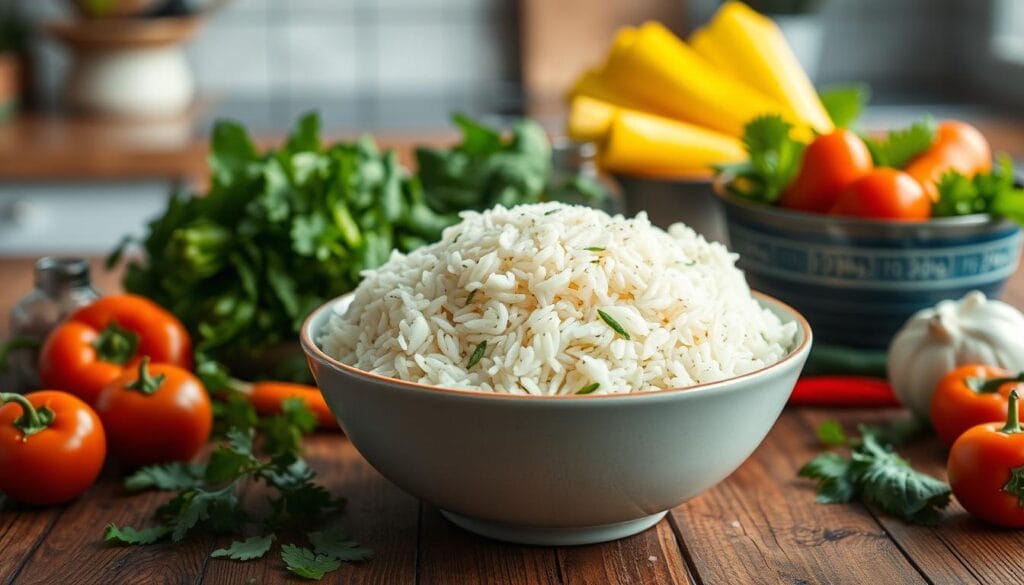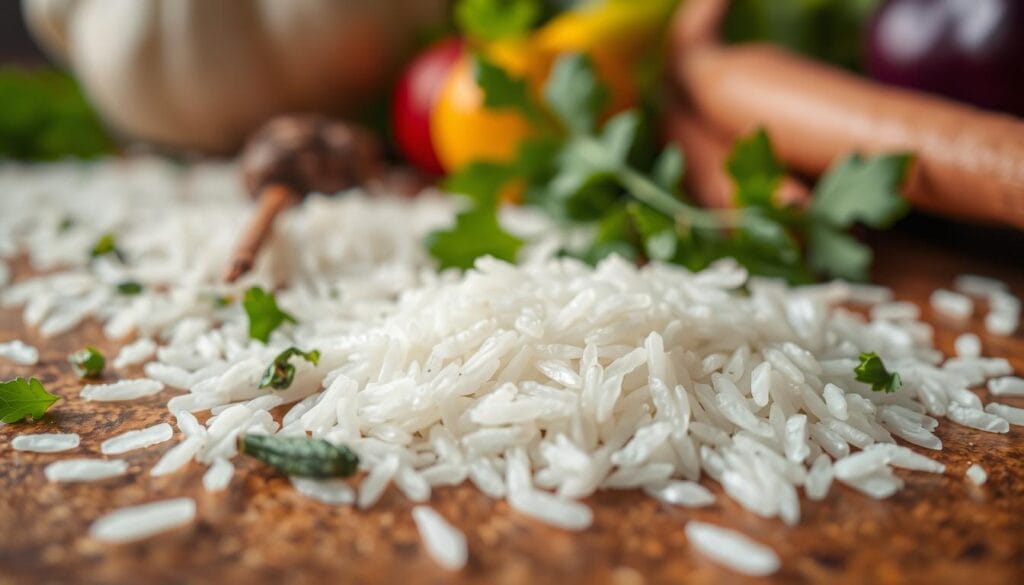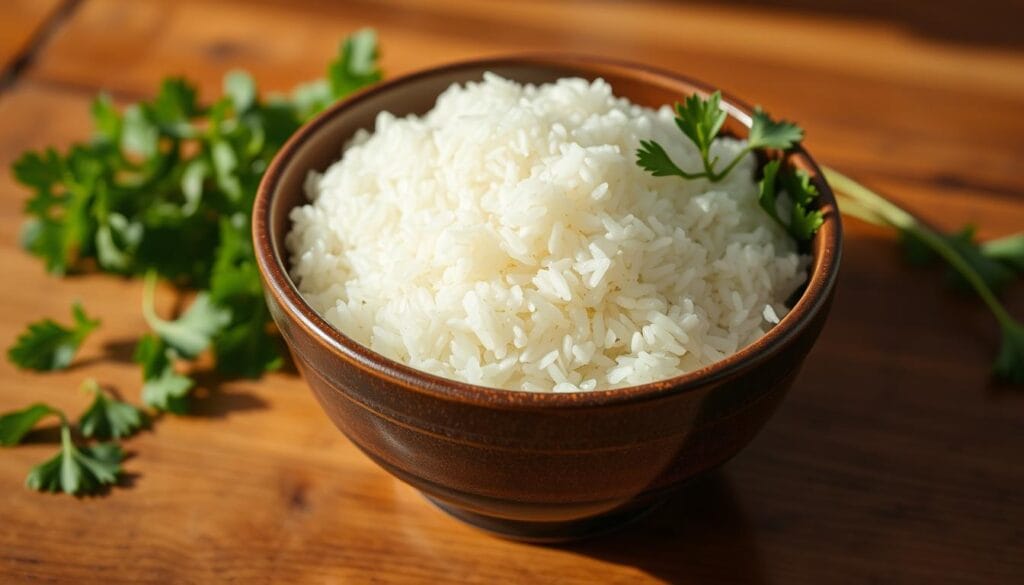Jasmine Rice Nutrition Info: Calories, Carbs, and Health Benefits
Jasmine rice is a long-grain variety known for its fragrant aroma. It’s packed with nutrients like carbs, vitamins B1 and B6, and minerals like magnesium and phosphorus. A cup of cooked jasmine rice has about 205 calories, 45 grams of carbs, 4 grams of protein, and almost no fat.
This rice is great for your brain, metabolism, and bones. It’s a key part of a healthy diet, giving you quick energy.

Table of Contents
Understanding Jasmine Rice Basics
Jasmine rice is a special type of long-grain rice from Thailand. It gets its name from the jasmine flower, known for its sweet scent. This rice comes in white, brown, red, and purple, each with its own taste and health benefits.
Types of Jasmine Rice Available
- White Jasmine Rice: Known for its soft, sticky texture and sweet flavor.
- Brown Jasmine Rice: Keeps the bran layer, offering more fiber and a nuttier taste.
- Red Jasmine Rice: Has a reddish bran layer, giving it a unique earthy flavor and more nutrients.
- Black Jasmine Rice (Riceberry): Rich in antioxidants, similar to blueberries and blackberries.
Origin and Characteristics
Jasmine rice comes from Thailand and is famous for its unique smell, texture, and taste. Its fragrance comes from a natural compound. White jasmine rice is more processed, while brown keeps the bran layer, which is full of nutrients.
Popular Uses in Global Cuisine
Jasmine rice is a key ingredient in Thai, Vietnamese, Cambodian, and Chinese cooking. It pairs well with curries, stir-fries, and grilled meats. Its light texture and sweetness enhance the flavors. It’s also used in desserts and snacks in Southeast Asia.
“Jasmine rice is a versatile and fragrant variety that has captured the hearts and palates of people around the world.”
Jasmine Rice Nutrition Info
Jasmine rice is a tasty and nutritious choice for many dishes. It comes in white and brown varieties. Knowing the calories and nutrients in each can guide your food choices.
A 100-gram serving of white jasmine rice has 356 calories. It has 80 grams of carbs, 7 grams of protein, and no fat or fiber. On the other hand, brown jasmine rice has 360 calories, 76 grams of carbs, 8 grams of protein, 3 grams of fat, and 4 grams of fiber.
| Nutrient | White Jasmine Rice (per 100g) | Brown Jasmine Rice (per 100g) |
|---|---|---|
| Calories | 356 | 360 |
| Carbohydrates | 80g | 76g |
| Protein | 7g | 8g |
| Fat | 0g | 3g |
| Fiber | 0g | 4g |
Brown jasmine rice is also rich in vitamins B1 and B3. It offers 2% of the daily value for iron.
“Rice is not just a staple food – it’s a nutritional powerhouse that can support your overall health and wellness.”
Knowing the jasmine rice nutritional value, jasmine rice calories, and jasmine rice carbs helps you choose wisely. This grain can be a great part of a healthy diet.
Caloric Content and Macronutrient Breakdown
Understanding the nutritional profile of jasmine rice is key. One cup (186g) of cooked white jasmine rice has 242 calories. Most of these calories come from carbs. Here’s the breakdown:
- Carbohydrates: 53.4g (88% of total calories)
- Protein: 4.39g (7.2% of total calories)
- Fat: 0.353g (1% of total calories)
Comparing White vs. Brown Jasmine Rice
White jasmine rice is a favorite, but brown jasmine rice has its own benefits. Brown jasmine rice has more calories, with 360 per 100g. It also has more fiber and essential vitamins and minerals than white rice.
| Nutrient | White Jasmine Rice (per 1 cup) | Brown Jasmine Rice (per 1 cup) |
|---|---|---|
| Calories | 242 | 248 |
| Carbohydrates | 53.4g | 51.7g |
| Protein | 4.39g | 5.54g |
| Fat | 0.353g | 2.64g |
| Fiber | 0.6g | 3.5g |
Choosing between white and brown jasmine rice depends on your taste and diet. Both have their own health benefits. Eating a variety of whole grains can improve your health.
Essential Vitamins and Minerals
Jasmine rice is not just tasty and flexible. It also packs essential vitamins and minerals for your health. Let’s dive into what makes this rice so nutritious.
Manganese is a key nutrient in jasmine rice. A single serving gives you over 30% of the daily manganese you need. It’s vital for strong bones and metabolism. Plus, jasmine rice is a good iron source, offering 15% of your daily value per serving.
This rice is also rich in B vitamins like thiamin, niacin, and riboflavin. These vitamins are key for energy and keeping your nervous system healthy. They support a lively and healthy lifestyle.
White and brown jasmine rice differ in their nutritional content. Brown jasmine rice has more selenium and manganese, both antioxidants. It also has more magnesium, which is good for bones and body functions.
| Nutrient | White Jasmine Rice | Brown Jasmine Rice |
|---|---|---|
| Calories | 246 | 248 |
| Protein | 4g | 5.5g |
| Carbohydrates | 44g | 52g |
| Fiber | 1g | 3g |
| Manganese | 30% DV | >30% DV |
| Iron | 15% DV | 15% DV |
| Selenium | – | Present |
| Magnesium | – | Present |
Knowing the nutritional value of jasmine rice helps you choose it wisely. It’s a great way to add essential vitamins and minerals to your diet.
Carbohydrate Profile and Glycemic Index
Understanding jasmine rice’s impact on blood sugar is key. It’s a fragrant and popular choice. White jasmine rice has about 45-53 grams of carbs per cooked cup.
The glycemic index (GI) shows how fast a food raises blood sugar. White jasmine rice has a GI of 73, while brown jasmine rice is about 68. This means white jasmine rice can cause quick blood sugar spikes, which may raise the risk of type 2 diabetes.
Understanding the GI Impact
The GI scale is from 0 to 100. Foods with a GI of 55 or less are low-GI. Those between 56-69 are medium-GI, and 70-100 are high-GI. Jasmine rice falls into the high category, like white bread and pretzels.
Blood Sugar Management Considerations
- To manage blood sugar, control jasmine rice portions. Pair it with low-GI foods like lentils, soybeans, or yogurt without sugar.
- Try brown or wild rice instead. They have lower GI scores and more fiber, making them healthier options.
- Remember, everyone reacts differently to foods. Pay attention to how jasmine rice affects you and adjust your intake.
Knowing jasmine rice’s carb profile and GI helps you make better choices. This way, you can manage your blood sugar and support your health.
Fiber Content and Digestive Benefits
White jasmine rice has very little fiber, with only 0.6 grams per cup. Brown jasmine rice, on the other hand, packs 3 grams of fiber per cup. This makes brown jasmine rice a better choice for your digestive health.
Fiber in brown jasmine rice helps keep your bowel movements regular. It also supports healthy cholesterol levels. Plus, the resistant starch in cooled jasmine rice may help your colon health and lower the risk of colon cancer.
“Jasmine rice, especially the brown variant, is known for its potential health benefits such as improved immune system, support for healthy pregnancies, and digestive health.”
If you want to add more fiber in jasmine rice for better jasmine rice digestive health, choose brown jasmine rice. This simple change can make your diet more nutritious and beneficial for your gut health.

Health Benefits of Jasmine Rice
Jasmine rice is a fragrant and versatile grain with many health benefits. It’s a nutritious choice for your diet. It provides quick energy, supports digestive health, and boosts athletic performance.
Energy Production
Jasmine rice is packed with complex carbohydrates, perfect for athletes and active people. It gives a steady energy boost for workouts and daily activities. White jasmine rice’s low fiber content means it’s quickly digested, giving you the energy to reach your fitness goals.
Digestive Health Support
Brown jasmine rice is rich in fiber, supporting digestive health. The fiber helps regulate bowel movements and promotes gut health. This is great for those looking to improve their digestive well-being.
Athletic Performance Benefits
Jasmine rice is great for athletes and fitness enthusiasts. It has manganese, which helps with energy production and supports bone health. Plus, it’s gluten-free, making it safe for those with gluten sensitivity or celiac disease.
Adding jasmine rice to your diet can improve your health in many ways. It boosts energy, supports digestive health, and enhances athletic performance. Whether you’re an athlete or just want to feel better, jasmine rice is a nutritious choice.
Cooking Methods and Nutrient Retention
Choosing the right way to cook jasmine rice is key to keeping its nutrients. Steaming is the top choice to keep its aroma and texture. Use a 1:1.5 rice-to-water ratio for steaming to cook it right without losing flavor.
Rinsing the jasmine rice before cooking is also a good move. It removes extra starch and stops clumping. This is crucial for dishes like sushi or pilafs, where you want the rice to be fluffy and separate.
The cooking method affects nutrient retention too. Steaming or boiling with little water keeps more vitamins and minerals. Letting the rice cool also boosts resistant starch, which is good for digestion and blood sugar.
| Cooking Method | Nutrient Retention |
|---|---|
| Steaming | High |
| Boiling with minimal water | Moderate |
| Rinsing before cooking | Helps preserve nutrients |
| Cooling cooked rice | Increases resistant starch |
Learning about the effects of different cooking jasmine rice methods helps you get the most health benefits. Enjoy your rice knowing it’s packed with nutrients.
Dietary Considerations and Restrictions
Jasmine rice is a great choice for those who need gluten-free options. It’s perfect for people with celiac disease or gluten sensitivity. But, make sure to pick jasmine rice brands that are certified gluten-free to avoid contamination.
Rice allergies are not common, but they can happen, especially in areas where rice is a big part of the diet. Jasmine rice might also cause food protein-induced enterocolitis syndrome (FPIES) in babies and young kids. If you or someone you know has food allergies or sensitivities, talk to a doctor before adding jasmine rice to your meals.

Gluten-Free Properties
Jasmine rice is naturally gluten-free. This makes it a good choice for people with celiac disease or those who follow a gluten-free diet. By picking jasmine rice from certified gluten-free places, you can enjoy its nutritional benefits without worrying about gluten.
Allergen Information
Rice allergies are not very common, but they can happen, especially in places where rice is eaten a lot. Jasmine rice might also cause food protein-induced enterocolitis syndrome (FPIES) in babies and young kids. If you or a family member has food allergies or sensitivities, it’s crucial to talk to a doctor before adding jasmine rice to your diet.
Storage Tips for Maximum Nutrition
Storing jasmine rice right is key to keeping its nutrients and preventing it from going bad. Here are some tips to help you enjoy your jasmine rice to the fullest:
For uncooked white jasmine rice, keep it in an airtight container in a cool, dry spot. It can last up to 10 years or more if the temperature stays below 70°F. Make sure to keep it away from moisture, heat, and sunlight.
Brown jasmine rice has a shorter shelf life because it has more oil. At room temperature, it can last about 6 months. To make it last longer, store it in the freezer for up to 1 year.
After cooking, jasmine rice should go in the fridge and be eaten within 3-4 days. Don’t leave cooked rice out for more than 2 hours, as bacteria can grow. To reheat, make sure the rice gets to 165°F to kill bacteria.
By following these storage tips for jasmine rice, you can keep its nutritional benefits and enjoy its taste for longer. Remember, managing the jasmine rice shelf life well is crucial for its quality and safety.
“Storing jasmine rice properly is essential to ensuring its freshness and nutritional value. Following the recommended storage guidelines can make a significant difference in the quality and longevity of your rice.”
Nutritional Comparison with Other Rice Varieties
There are many rice types to pick from, each with its own nutritional benefits. Let’s compare jasmine rice with basmati rice and white rice.
Jasmine rice has similar calories and carbs to white rice but more protein. Basmati rice has a lower glycemic index than jasmine rice. This makes it better for managing blood sugar.
Brown rice, including brown jasmine rice, is a healthier choice. It has more dietary fiber, vitamins, and minerals than white rice.
Wild rice is not really rice but is very nutritious. It has more vitamins, minerals, and fiber than white jasmine rice. It’s a great choice for a healthy diet.
| Nutritional Comparison | Jasmine Rice | Basmati Rice | White Rice | Brown Rice | Wild Rice |
|---|---|---|---|---|---|
| Calories (per 45g) | 160 | 150 | 160 | 160 | 160 |
| Protein (g) | 3 | 4 | 3 | 4 | 6 |
| Carbohydrates (g) | 36 | 38 | 36 | 35 | 34 |
| Fiber (g) | 0 | 1 | 0 | 2 | 3 |
| Glycemic Index | Moderate | Low-Moderate | Moderate | Low-Moderate | Low |
Each rice type has its own nutritional benefits. Think about your dietary needs and preferences when choosing rice for your meals.
Conclusion
Jasmine rice can be a great addition to a balanced diet if eaten in moderation. It gives you quick energy and important vitamins and minerals. Plus, it’s versatile in many dishes around the world.
The brown version of jasmine rice has even more health benefits. It has more fiber and nutrients than the white version.
When you add jasmine rice to your meals, think about your diet needs and how it affects your blood sugar. It’s also good to know how to cook it best. Jasmine rice is gluten-free and has many health benefits. But, it might not have enough protein for everyone, so you might need to add other protein sources.
In the end, jasmine rice can be a nutritious part of a healthy diet. It gives you energy, important nutrients, and tastes great. By knowing what it offers and making smart choices, you can enjoy jasmine rice as part of a healthy lifestyle.
FAQ
What is the calorie and nutritional content of jasmine rice?
A 1-cup serving of cooked jasmine rice has about 205 calories. It also has 45 grams of carbs, 4 grams of protein, and less than 1 gram of fat. It’s a good source of vitamins B1 and B6, and minerals like magnesium and phosphorus.
What are the different varieties of jasmine rice?
Jasmine rice comes in white, brown, red, and purple varieties. The unique aroma comes from a compound called 2-acetyl-1-pyrroline. White jasmine rice is more processed, while brown jasmine rice keeps more of its natural nutrients.
How does the nutrition differ between white and brown jasmine rice?
White jasmine rice has 356 calories, 80 grams of carbs, and 7 grams of protein per 100 grams. Brown jasmine rice has 360 calories, 76 grams of carbs, 8 grams of protein, 3 grams of fat, and 4 grams of fiber per 100 grams. Brown jasmine rice is also richer in vitamins B1, B3, and iron.
What are the key health benefits of jasmine rice?
Jasmine rice is an excellent source of manganese, providing over 30% of the daily value. It also contains iron, thiamin, niacin, and riboflavin. The magnesium in jasmine rice aids in energy production and bone health. Its gluten-free nature makes it suitable for those with celiac disease or gluten sensitivity.
How does the glycemic index of jasmine rice impact blood sugar?
White jasmine rice has a high glycemic index of around 73, while brown jasmine rice has a lower GI of about 68. The high GI of white jasmine rice can cause rapid blood sugar spikes. This may increase the risk of type 2 diabetes if consumed frequently. For better blood sugar management, portion control and pairing jasmine rice with low-GI foods is recommended.
What are the fiber benefits of brown jasmine rice?
Brown jasmine rice provides about 3 grams of fiber per cup, compared to only 0.6 grams in white jasmine rice. The fiber in brown jasmine rice aids digestion, promotes regularity, and helps lower cholesterol levels. Resistant starch formed when rice is cooled after cooking may also benefit colon health.
How should jasmine rice be stored to preserve its quality?
Uncooked white jasmine rice should be stored in an airtight container in a cool, dry place. It can last 10 years or more at temperatures below 70°F. Brown jasmine rice has a shorter shelf life of about six months at room temperature or one year in the freezer due to its higher oil content. Cooked jasmine rice should be refrigerated and consumed within 3-4 days.
How does jasmine rice compare nutritionally to other rice varieties?
Compared to white rice, jasmine rice has a similar calorie and carbohydrate content but a slightly higher protein content. Basmati rice has a lower glycemic index than jasmine rice. Brown rice varieties, including brown jasmine rice, offer more fiber and nutrients than their white counterparts. Wild rice, though not true rice, provides more vitamins, minerals, and fiber than white jasmine rice.
DID OUR INFORMATION HELP YOU ?
There are no reviews yet. Be the first one to write one.

